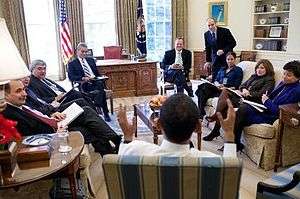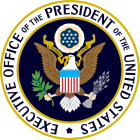White House Office
 | |
| Agency overview | |
|---|---|
| Formed | 1857 |
| Headquarters | West Wing of the White House |
| Employees | About 150 |
| Agency executive | |
| Parent agency | Executive Office of the President of the United States |
| Website | White House Office |

Individuals present (l–r): David Axelrod (Senior Advisor), Jim Messina (Deputy Chief of Staff), Pete Rouse (Senior Advisor), Rahm Emanuel (Chief of Staff), Robert Gibbs (Press Secretary), Phil Schiliro (Director of Legislative Affairs), Mona Sutphen (Deputy Chief of Staff), Alyssa Mastromonaco (Director of Scheduling and Advance) and Valerie Jarrett (Senior Advisor).
The White House Office is an entity within the Executive Office of the President of the United States. The White House Office is headed by the White House Chief of Staff, who is also the head of the Executive Office.[1] The staff of the various offices are based in the West Wing and East Wing of the White House, the Eisenhower Executive Office Building, and the New Executive Office Building. It is made up of personal assistants to the president with offices in the White House. These aides oversee the political and policy interests of the president and do not require Senate confirmation for appointment. They can be removed at the discretion of the president (Examples: National Security Adviser, special consultant to the president)
History
Established in the Executive Office of the President by Reorganization Plan 1 of 1939 and Executive Order 8248 to provide assistance to the President in the performance of his many detailed activities incident to his immediate office. The White House Office is organized in accordance with the wishes of each incumbent President and is directed by staff chosen by the President. A staff authorization was initially established in 1978 (92 Stat. 2445). Some presidential boards, committees, and commissions function organizationally as subunits of the White House Office.[2]
Although still a subunit of the EOP, the White House Office remains the centerpiece of the presidential staff system. In many ways it is closest to the President both in physical proximity, its top aides occupy most of the offices in the West Wing, and in its impact on the day-to-day operations, deliberations, policy agendas, and public communications of a presidency. During the transition to office and continuing throughout an administration, the President enjoys a great deal of discretion in terms of how the White House Office is organized.[1]
Mission
The issues that confront the United States at any one time can not be dealt with by the President alone, and therefore he (or she) must draw on the expertise to administration and even within an administration as one chief of staff may differ from a predecessor or successor. While Chiefs of Staff may differ in the degree of policy advice they provide a President, they are at base the managers of the White House staff system. At least in theory, they are the coordinators bringing the pieces together; they are the tone-setters and disciplinarians making for good organizational order, and often act as the gatekeeper for the President, overseeing every person, document and communication that goes to the President.[1]
Organization
Office of the Chief of Staff
- Assistant to the President and White House Chief of Staff: Denis McDonough
- Assistant to the President and Deputy Chief of Staff for Operations: Anita Decker Breckenridge
- Assistant to the President and Deputy Chief of Staff for Implementation: Kristie Canegallo
- Senior Advisor and Assistant to the President for Public Engagement and Intergovernmental Affairs: Valerie Jarrett
- Assistant to the President and Senior Advisor: Brian Deese
- Assistant to the President and Senior Advisor: Shailagh Murray
Domestic Policy Council
- Assistant to the President and Director of the Domestic Policy Council: Cecilia Muñoz
- Office of National AIDS Policy
- Office of Faith-based and Neighborhood Partnerships
- Office of Social Innovation and Civic Participation
- White House Rural Council
National Economic Council
- Assistant to the President for Economic Policy and Director of the National Economic Council: Jeffrey Zients
Office of Cabinet Affairs
- Assistant to the President and Cabinet Secretary: Broderick D. Johnson
Office of Communications
- Assistant to the President and White House Communications Director: Jen Psaki
- Deputy Assistant to the President and Deputy Director of Communications: Liz Allen
- Office of the Press Secretary
- Assistant to the President and White House Press Secretary: Josh Earnest
- Office of Speechwriting
- Assistant to the President and Director of Speechwriting: Cody Keenan
Office of Digital Strategy
- Deputy Assistant to the President and Chief Digital Officer: Jason Goldman
Office of the First Lady
- Assistant to the President and Chief of Staff to the First Lady: Tina Tchen
- Deputy Assistant to the President and Senior Advisor to the First Lady: Melissa Winter
- Special Assistant to the President and White House Social Secretary: Deesha Dyer
Office of Information Technology
- Special Assistant to the President and Director of White House Information Technology: David Recordon
Office of Legislative Affairs
- Assistant to the President for Legislative Affairs: Amy Rosenbaum
- Deputy Assistant to the President for Legislative Affairs:
- Deputy Assistant to the President for Legislative Affairs and House Liaison: Alejandro Perez
- Deputy Assistant to the President for Legislative Affairs and Senate Liaison: Martin Paone
- Deputy Assistant to the President for Legislative Affairs:
Office of Management and Administration
- Assistant to the President for Management and Administration: Maju Varghese
- Deputy Assistant to the President for Management and Administration: Katherine Dickerson
- White House Operations
- White House Personnel
- White House Photo Office
- White House Visitors Office
- Office of Administration
- Deputy Assistant to the President for Management and Administration: Katherine Dickerson
Office of the National Security Advisor
- Assistant to the President and National Security Advisor: Susan Rice
- Assistant to the President and Deputy National Security Advisor: Avril Haines
- Assistant to the President for Homeland Security And Counterterrorism and Deputy National Security Advisor: Lisa Monaco
- Assistant to the President and Deputy National Security Advisor for Strategic Communications and Speechwriting: Ben Rhodes
Office of Political Strategy and Outreach
- Assistant to the President and Director of the Office of Political Strategy and Outreach: David Simas
- Special Assistant to the President and Deputy Director of the Office of Political Strategy and Outreach: Caitria L. Mahoney
Office of Presidential Personnel
- Assistant to the President and Director of Presidential Personnel: Rudy A. Mehrbani
Office of Public Engagement and Intergovernmental Affairs
- Senior Advisor and Assistant to the President for Intergovernmental Affairs and Public Engagement: Valerie Jarrett[3]
- Deputy Assistant to the President for Intergovernmental Affairs and Public Engagement: Yohannes Abraham[4]
- Office of Public Engagement
- Deputy Assistant to the President and Director of Public Engagement: Paulette Aniskoff
- Office of Intergovernmental Affairs
- Deputy Assistant to the President and Director of Intergovernmental Affairs: Jerry Abramson[5]
- Council on Women and Girls
- Chair of the Council on Women and Girls: Valerie Jarrett[6]
- Office of Urban Affairs, Justice and Opportunity
- Deputy Assistant to the President for the Office of Urban Affairs, Justice and Opportunity: Roy Austin, Jr.
Office of Scheduling and Advance
- Assistant to the President and Director of Scheduling and Advance: Chase Cushman
Office of the Staff Secretary
- Deputy Assistant to the President and Staff Secretary: Joani Walsh
- Office of Presidential Correspondence
- Office of the Executive Clerk
- Office of Records Management
Office of the White House Counsel
- Assistant to the President and Counsel to the President: W. Neil Eggleston
- Deputy Assistant to the President and Deputy Counsel to the President: Michael Bosworth
- Deputy Assistant to the President and Deputy Counsel to the President: Nicholas L. McQuaid
- Deputy Assistant to the President and Deputy Counsel to the President: Christopher Fonzone
Oval Office Operations
- Director of Oval Office Operations (Brian Mosteller)
- Personal Secretary to the President (Ferial Govashiri)
- Personal Aide to the President (Joseph Paulsen)
White House Fellows
- Director, President's Commission on White House Fellowships: Cindy S. Moelis[7]
White House Military Office
- Assistant to the President and Director of the White House Military Office: Emmett Beliveau
- Deputy Director of the White House Military Office for Operations:
- White House Communications Agency (Joint Services Unit)
- Presidential Airlift Group (United States Air Force)
- White House Medical Unit (United States Navy)
- Deputy Assistant and Physician to the President:
- Camp David (United States Navy)
- Marine Helicopter Squadron One (United States Marine Corps)
- White House Mess or Presidential Food Service (United States Navy)
- White House Transportation Agency (United States Army)
- General Counsel
References
- 1 2 3 John P. Burke. "Administration of the White House". Miller Center of Public Affairs, University of Virginia. Retrieved June 6, 2009.
- ↑ Harold C. Relyea (March 17, 2008). "The Executive Office of the President: An Historical Overview" (PDF). Congressional Research Service. Retrieved April 14, 2008.
- ↑ "President-elect Obama and Vice President-elect Biden announce key White House staff" (Press release). Office of the President-Elect. Retrieved April 21, 2009.
- ↑ Slack, Donovan. "More White House staff changes . . .". Politico.
- ↑ Loftus, Tom (2014-11-06). "Abramson resigns to work for Obama". The Courier-Journal. Retrieved November 7, 2014.
- ↑ "Establishing A White House Council On Women And Girls" (Press release). Office of the Press Secretary. March 11, 2009. Retrieved June 5, 2009.
- ↑ "President Obama Appoints Cindy S. Moelis as the Director for the Presidential Commission on White House Fellows" (Press release). Office of the Press Secretary. April 21, 2009. Retrieved June 7, 2009.
